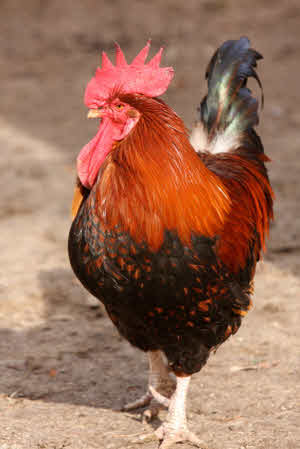 The Environment and Poultry Behaviour by Katie Thear
The Environment and Poultry Behaviour by Katie Thear
The type of environment plays a major part in poultry behaviour, with flock density being foremost. The more birds there are in a given area, the more likely they are to peck at each other
Small, non-intensive flocks generally have fewer problems, not only because there are less of them, but also because they have more space in which to run away from potential bullies. Once the victim has signalled defeat in this way, the aggressor will usually lose interest.
It is important to stress this flock density aspect for if a small flock is confined in a small area it is just as likely to suffer from incidences of feather and vent pecking and cannibalism as a large one.
Don’t forget that providing hanging greens or one of those grain balls can provide interest for otherwise bored birds, so that they do not develop bad habits.
Large free-range houses are required to have sufficient wide pop-holes so that the chickens can find their way out easily. In this way, a relatively free flow of traffic is ensured. Large houses also control the lighting so that if there are incidences of feather pecking (or egg eating) the lights can be dimmed.
Health and Condition
A bird that is sick tends to be picked on. A sick bird should always be isolated to protect it, as well as to stop the potential spread of infection to the remainder of the flock.
A bird that is moulting or injured in some way attracts the attention of feather or vent peckers. Lice and mite infestations often have the bird pecking at their own feathers in order to gain relief, a habit that other birds will then continue.
Once blood flows, it excites even more attention and can ultimately lead to cannibalism.
Regular checks should be carried out on birds and housing to ensure that there are no external parasites. If there are, they can be eliminated with any of the appropriate products that are available from licensed poultry suppliers or vets. There is a welfare requirement for all those who keep domestic fowl, whether they are in large or small numbers, to keep them free of parasites.
Diet – Protein Content
A balanced diet with sufficient protein to cater for healthy feather growth is essential. The main constituent of feathers is protein, so a deficiency can soon lead to problems.
A mineral deficiency or shortage of fresh water can also trigger an aggressive habit. There are now excellent free-range and organic rations available for poultry, whether they are layers, table birds or breeders, so there is no reason why any bird should suffer from malnutrition. It is not quantity but quality that counts.
Parasitic Poultry Worms
Free-ranging flocks are also subject to parasitic worms, hence the importance of providing clean pasture on a regular basis. If there is a problem, the flock can be dosed with a worm preparation added to the feed. As there is usually a ‘withdrawal period’ when eggs should be discarded after treatment, an appropriate time to dose them is when they have stopped laying during the moulting period.
Conclusion
To sum up, the best approach is to avoid problems before they start. This means choosing a breed or strain that has been selectively bred for docility, keeping the flock size small, allowing plenty of room to range and feeding and managing them properly.
Further Articles on Aggression in Poultry
- Aggressive Poultry Breeds – Dealing with Aggression in Poultry
- Environment and Poultry Behaviour and Aggression
- Male Aggression (Cockerels) in Poultry – Dealing with Aggressive Cockerels
- Pecking Order in Hens – Dealing with Aggressive Poultry

